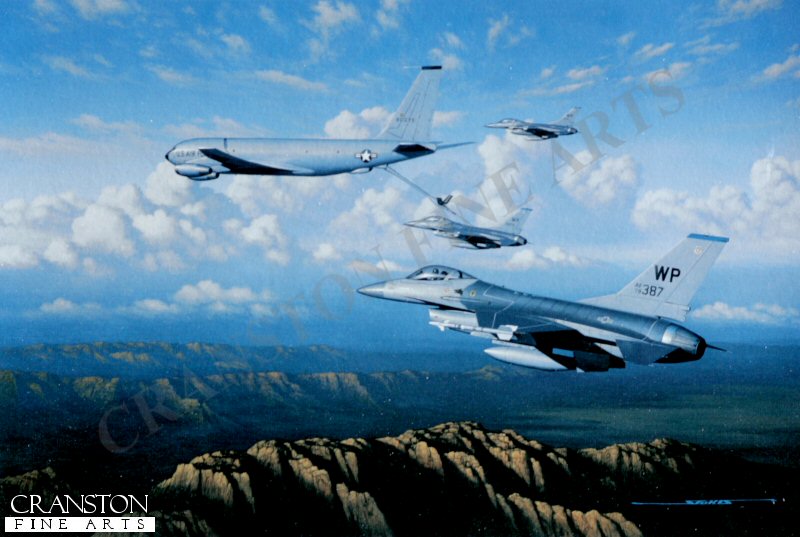- Sku:
- Vendor: Military Aviation Art Prints
Thirsty Falcons by Stan Stokes.
Aerial refueling revolutionized aerial warfare. The first such documented refueling took place in June of 1923 when a specially modified DH-4B piloted by Lts. Virgil Hine and Frank Seifert took off from Rockwell Field in San Diego and managed to refuel another DH-4 piloted by Capt. Lowell Smith. The success of this aerial refueling permitted an attempt at a world record of flight duration. Taking off again from Rockwell Field Smith kept his aircraft airborne for more than 33 hours. Aerial refueling remained a novelty until many decades later when the jet age arrived. Modern jet-powered fighters are awesome machines, but they can consume enormous amounts of fuel, especially when flying at maximum speeds or climbing under maximum power. A jet taking off with a full weapons load that climbs to 60,000 feet under full power may consume more than half its fuel capacity. Aerial refueling was necessary to make jet powered fighters and bombers a practical weapon. In the 1950s the Air Force developed a flying boom method of refueling whereas the Navy utilized a probe and drogue system. The former required a specially trained boom operator but can pass fuel very quickly. The Navy system could handle multiple aircraft at the same time, but required a higher standard of flying. Both in Vietnam and later during the Gulf War, aerial refueling proved invaluable to the success of the air campaigns. In Stan Stokes painting, F-16 Falcons approach their tanker for refueling. The F-16 Fighting Falcon, designed by Harry Hillaker, first rolled out of the General Dynamics assembly line in Ft. Worth Texas in October of 1976. The aircraft was originally built as a technology demonstration exercise to show how much weight and cost could be eliminated from the F-15 Strike Eagle. In 1975, at the Paris Air Show, the F-16 prototype with test pilot Neal Anderson at the controls competed in the Great Fighter Competition. To the winner; billions of potential sales to countries like Belgium, Denmark, the Netherlands, and Norway. The F-16 duked it out against the French-built Mirage F1-E and the Swedish Saab 37 Viggen. The F-16 was the winner. Interest in a new lightweight, cost-effective, fighter-interceptor evolved in the mid-1970s as a replacement for the aging F-104. The F-16s outward appearance has remained the same for twenty-five years while remarkable advances in technology have been incorporated into the aircrafts internals. Improved engines, enhanced radar and avionics, and superior missiles have kept the F-16 effective. The F-16 can carry nearly ten tons of armament on its external stores stations. This range of armament includes air-to-air missiles, air-to-ground missiles, intelligent and traditional bombs, 6000 round per minute Vulcan guns, and external fuel tanks.
Supplied with signed and numbered certificate of authenticity.
Signed limited edition of 4750 prints.
Print size 16 inches x 11.5 inches (41cm x 30cm)
Have a question?

Thirsty Falcons by Stan Stokes.


